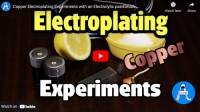Hello everybody, not sure this is the right sub-forum for this topic, even though after all an electrolytic paintbrush should be deemed as a tool, right? What's an electrolytic paintbrush? Well, it's a fancy name for a trivial electrode covered with a colth drenched with an electrolyte.
I am sharing my experiments with a simple method for electroplating copper on steel. The video went quite long (>20') but I've tried to explain how the process works and some attempts to improve it, including using lemon juice!
Notice I am not a chemist, so if you spot any mistake please tell me either in the video's comments section or here.
Hope you'll find it interesting. Cheers. Claudio.


 LinkBack URL
LinkBack URL About LinkBacks
About LinkBacks




 Reply With Quote
Reply With Quote






Bookmarks